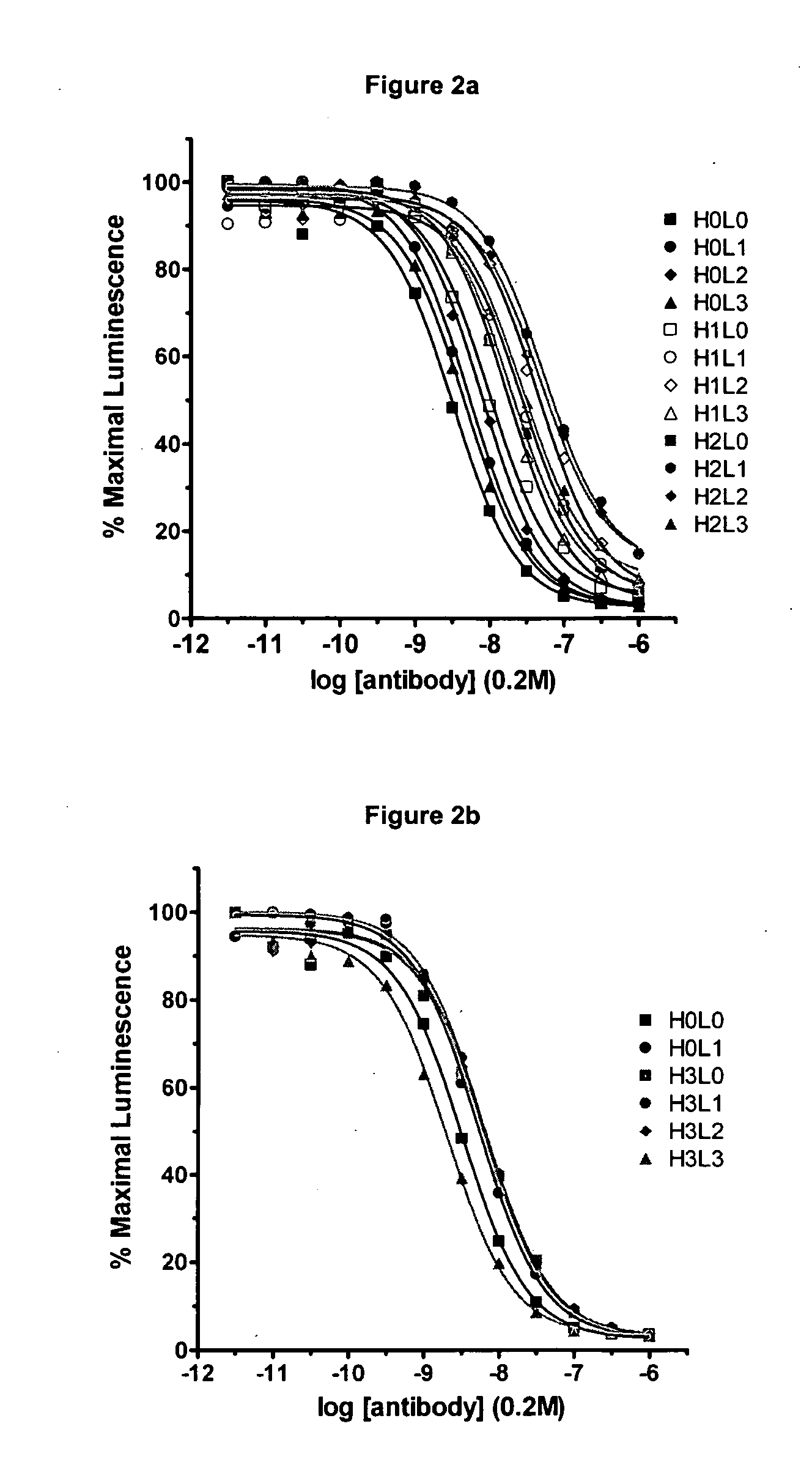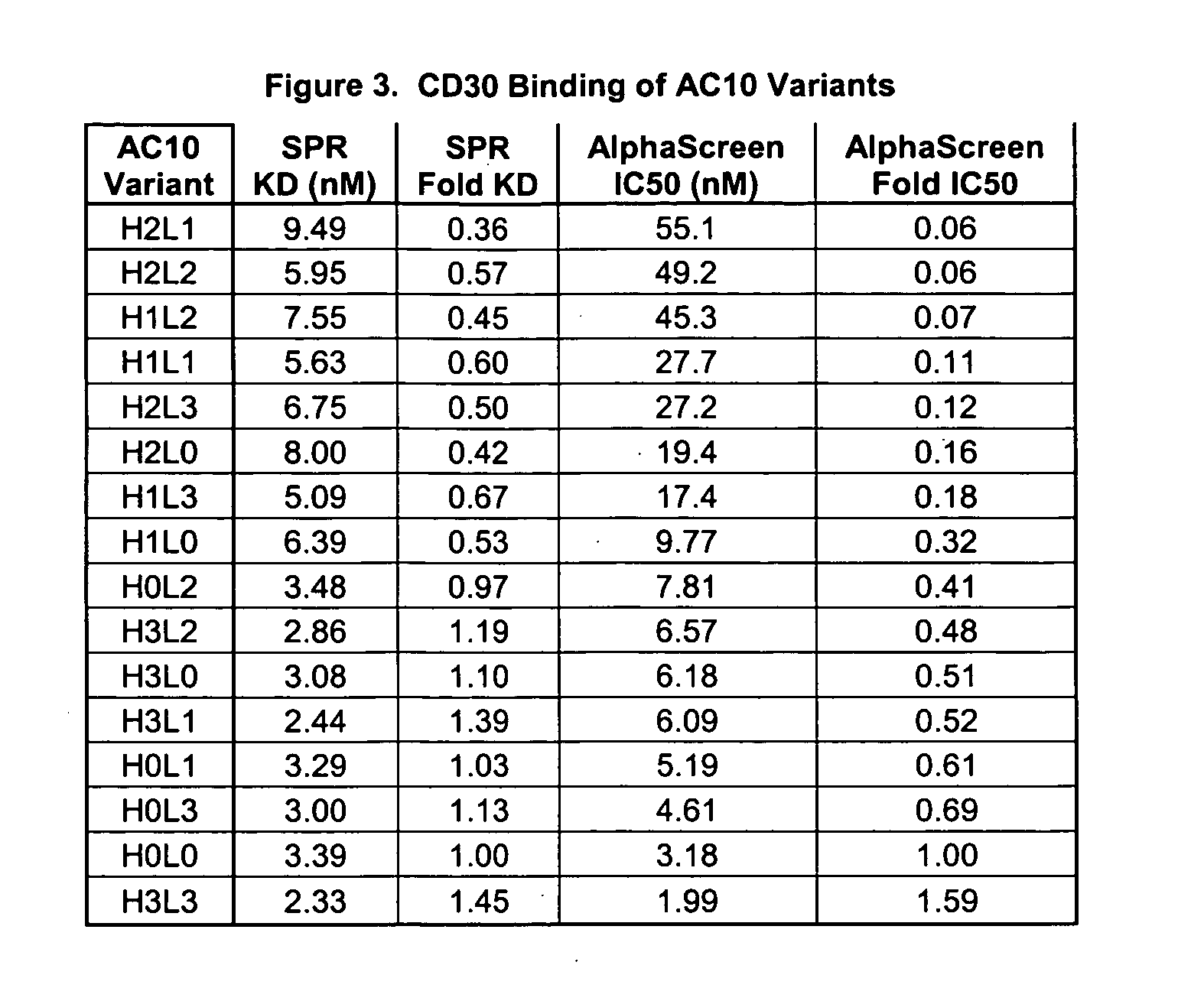Optimized anti-CD30 antibodies
an anticd30 antibody, optimized technology, applied in the field of proteins, can solve the problems that anti-cd30 antibodies have not been successful clinically, and achieve the effect of reducing fucosylation
- Summary
- Abstract
- Description
- Claims
- Application Information
AI Technical Summary
Benefits of technology
Problems solved by technology
Method used
Image
Examples
example 1
Antibody Fv Regions that Target CD30
[0242] Variants of the anti-CD30 antibody AC10 (Bowen et al. Journal of Immunology, 1993, 151: 5896) (sequences provided in FIG. 1) were generated to reduce immunogenicity in humans by applying a string optimization algorithm, as described in U.S. Ser. No. 11 / 004,590 (herein entirely incorporated by reference). This algorithm heuristically samples multiple amino acid mutations that exist in the diversity of the human VLK and VH germlne sequences, and calculates the host string content (HSC). Variant sequences were also evaluated for structural and functional integrity using a nearest neighbor structure-based scoring method (U.S. Ser. No. 60 / 528,229, filed Dec. 8, 2003, entitled Protein Engineering with Analogous Contact Environments). A series of variant heavy chain (referred to as H1, H2, and H3) and light chain (L1, L2, and L3) AC10 sequences were chosen to characterize experimentally.
[0243] The genes for the variable regions of AC10 WT (L0 an...
example 2
Anti-CD30 Antibodies with Amino Acid Modifications that Enhance Effector Function
[0253] Because the provided AC10 variants antibodies are clinical candidates for anti-cancer therapeutics, it may be advantageous to optimize their effector function. As previously described, substitutions can be engineered in the constant region of an antibody to provide favorable clinical properties. Combinations of the variants of the present invention with Fc modifications that alter effector function are anticipated. In a most preferred embodiment, one or more amino acid modifications that provide optimized binding to FcγRs and / or enhanced effector function described in U.S. Ser. No. 10 / 672,280, PCT US03 / 30249, and U.S. Ser. No. 10 / 822,231, and U.S. Ser. No. 60 / 627,774, filed Nov. 12, 2004 and entitled “Optimized Fc Variants,” each of which is incorporated by reference in its entirety, are combined with the AC10 variants of the present invention. The optimal anti-CD30 clinical candidate may compri...
example 3
Anti-CD30 Antibodies with Modified Carbohydrates that Enhance Effector Function
[0260] Carbohydrates attached to the antibodies described herein may be modified. For example, the antibodies may be modified as described by Chowdhury & Wu, 2005, Methods 36:11-24, incorporated herein by reference in its entirety. .
[0261] Glycoengineering.
[0262] An IgG molecule contains two N-linked glycan chains attached to Asn297 in each of its heavy chains and is part of the Fc portion. It is well known that IgG is produced as a heterogeneous populationof gylcoforms in mammalian cells. Fc glycosylation is important for the interaction with Fc receptors. This interaction is known to be sensitive to changes in the oligosaccharide structures of the Fc region (Wright & Morrison, 1998, J. Immunol. 160:3393-3402; Lund et al., 1996, J. Immunol. 157:4963-4969. The oligosaccharide core normally found attached to the human IgG Fc is of the bi-antennary type and consists of Asn297-linked GlcNAc(Fuc)-GlcNAc-Ma...
PUM
| Property | Measurement | Unit |
|---|---|---|
| molecular weight | aaaaa | aaaaa |
| molecular weight | aaaaa | aaaaa |
| time | aaaaa | aaaaa |
Abstract
Description
Claims
Application Information
 Login to View More
Login to View More - R&D
- Intellectual Property
- Life Sciences
- Materials
- Tech Scout
- Unparalleled Data Quality
- Higher Quality Content
- 60% Fewer Hallucinations
Browse by: Latest US Patents, China's latest patents, Technical Efficacy Thesaurus, Application Domain, Technology Topic, Popular Technical Reports.
© 2025 PatSnap. All rights reserved.Legal|Privacy policy|Modern Slavery Act Transparency Statement|Sitemap|About US| Contact US: help@patsnap.com



